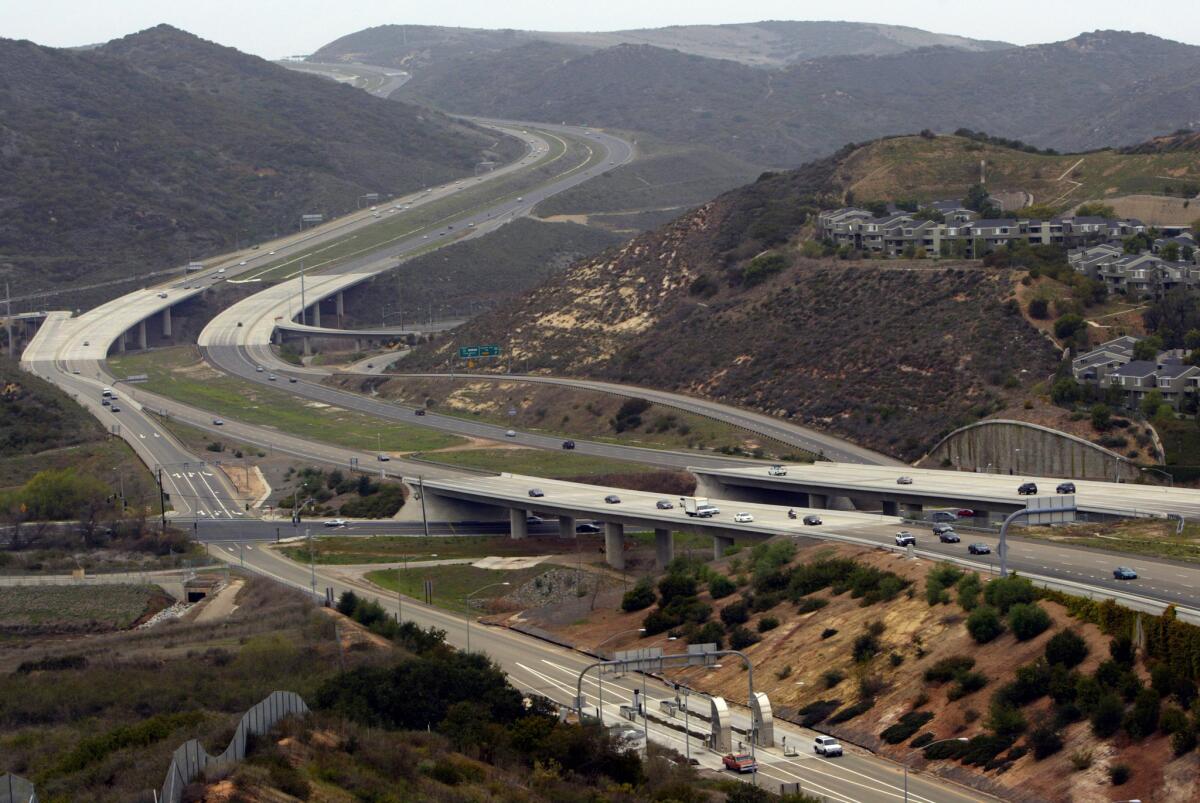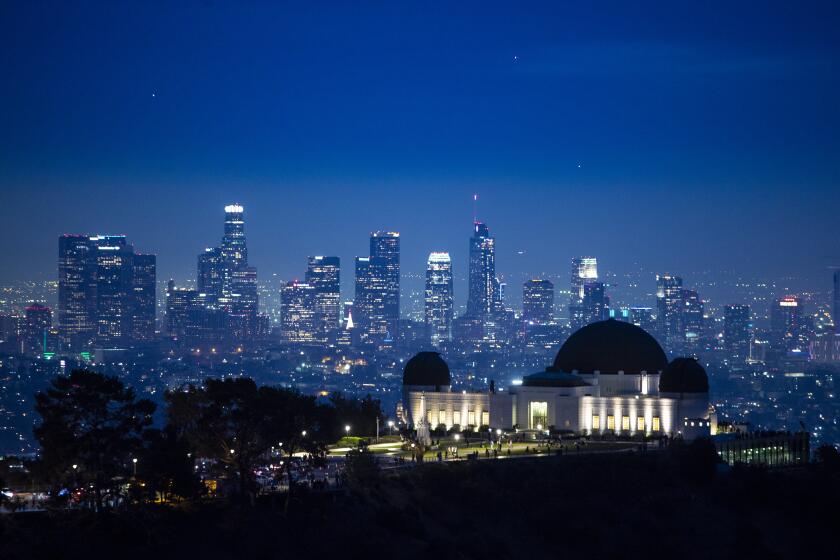Orange County toll roads under review by California

- Share via
When it opened during the 1990s, Orange County’s $2.4-billion tollway system was touted as an innovative way to build public highways without taxpayer money.
Today, the roads offer smooth sailing for gridlock-weary commuters willing to pay the price. But far fewer people are using the turnpikes than officials predicted, which means the highways generate far less revenue than expected to retire their debts.
There have long been questions about the long-term financial viability of the San Joaquin Hills and Foothill-Eastern corridors. But those concerns have now heightened, and a government oversight panel chaired by state Treasurer Bill Lockyer has launched a formal inquiry into whether the roads can cover mounting interest payments to private investors who purchased tollway bonds.
The review was prompted by former Orange County Assemblywoman Marilyn Brewer, who questions whether the debt-laden toll road agency is “viable as a going concern.”
“I think they are in trouble,” Brewer said. “I don’t believe there is malfeasance, but it’s no way to run a railroad or a toll road.”
The roads, which rely on motorist tolls and fees from new developments in the area, have been battered by economic recessions, lower-than-expected population growth and competing public highways, such as Interstates 5 and 405, both of which have been widened and improved by Caltrans.
Wall Street ratings agencies have reduced the San Joaquin Hills toll road’s bonds to junk status and the notes for the Foothill-Eastern corridor to the lowest investment grade.
To meet expenses and debt payments, the corridor agency has refinanced the San Joaquin Hills bonds, raised tolls more than originally planned, slashed administrative costs and obtained repayment concessions from bondholders. Early next year, officials plan to refinance about $2.4 billion in notes issued to build the Foothill-Eastern tollway.
In 2011, ridership on the San Joaquin Hills, which has never performed as predicted, was only 43% of original forecasts, and its revenue was 61% of projections. The road parallels the Orange County coast, slicing south from Irvine through Newport Beach, Laguna Beach and Aliso Viejo to the San Diego Freeway.
Motorists on the Foothill-Eastern last year numbered 33% less than projected, and revenue was 75% of forecasts. Previously, the part of the corridor between Yorba Linda and Rancho Santa Margarita had a revenue surplus and ridership that was often 8% to 10% ahead of projections. The extra money was used to help shore up the finances of the San Joaquin Hills road.
Last year, the San Joaquin Hills restructured about $2.1 billion in debt and pushed back the retirement of its bonds to 2042, meaning motorists will have to pay tolls for an additional six years before the road becomes a free highway. It is the second time the original deadline of 2033 has been reset.
“Extending the payment time to make sure we can make our debt payments is a necessary step,” said Amy Potter, the Transportation Corridor Agencies’ chief financial officer. “We have to be flexible.”
Overall, the agency has borrowed about $4.4 billion for the two roads and faces at least $10.5 billion in debt payments by the time its bonds mature, according to financial statements.
Despite the roads’ sagging ridership, the agency has increased tolls repeatedly to keep pace with expenses and debt payments—at least 12 times since 1996 on the San Joaquin Hills alone.
The tolls on both corridors are now among the highest in the nation per mile. A round trip at peak travel times on the San Joaquin Hills costs $11, almost three times what it was in 1996. The maximum toll for a round trip on the Foothill-Eastern has roughly doubled to between $3.40 and $4.90 during peak times, depending on the section.
Tollway officials acknowledge the financial duress but say that they have never missed a debt payment and that the latest traffic figures show revenue has been increasing this year, though less than had been hoped.
“We have a responsibility to make sure this works,” said Lisa Telles, acting chief executive of the Irvine-based toll agency, which operates 51 miles of highways. “Tolling is being talked about more and more throughout the country as a way to build infrastructure. People still look at us today as a model, but we have had to adjust with the times and the recession, which has hit everybody.”
In addition to being reviewed by the California Debt and Investment Advisory Commission, the toll roads also are receiving scrutiny from a major Los Angeles law firm that helped to defeat plans to extend the Foothill-Eastern corridor through San Onofre State Park.
Among other things, SNR Denton found that the tollway agency renegotiated an agreement with San Joaquin Hills bondholders in 2011 that lowered by almost 23% the amount of revenue the agency had promised to take in for every dollar of debt.
In exchange, the agency agreed to increase debt payments to bondholders by more than $850 million based on the deferral of $430 million in principal payments for up to 19 years.
“It is hard to see how they can grow their revenue to keep up with the rapidly increasing levels of debt service,” said attorney Tom Vandiver, a public finance expert at the law firm.
Vandiver described the toll road’s situation as “a time bomb waiting to happen,” adding that the economic problems could lead to a default on bond payments or a potential bankruptcy.
Retired professor G.J. “Pete” Fielding, formerly of UC Irvine’s Institute of Transportation Studies, blamed the financial problems on inaccurate revenue and ridership forecasts by private consultants, resulting in six- and eight-lane highways that were larger and more expensive to build than necessary.
Fielding predicted in the mid-1990s that the San Joaquin Hills, for example, would suffer from a lack of motorists. He suggested that a four-lane road would have been adequate for many years as long as tolls were raised and lowered based on demand — so-called congestion pricing.
Given the current situation, Brewer and the Denton firm question whether the toll road agency can afford to extend the southern end of the Foothill-Eastern corridor — a proposal the agency is still pursuing despite years of political and legal setbacks for a route through San Onofre.
The revised project would cost an estimated $200 million and run five miles between Oso Parkway in Rancho Santa Margarita and Ortega Highway east of San Juan Capistrano.
Denton’s investigation notes that if the Foothill extension cannot be built, the San Joaquin Hills might have to return a $120-million payment from the Foothill-Eastern corridor made in 2005. The money was compensation for the possibility that the new road would siphon traffic away from the San Joaquin Hills.
“An assessment needs to be done before further debt is incurred and the citizens of Orange County are made to suffer serious consequences,” Brewer stated in her letter to Lockyer.
Should the agency be unable to cover its debts, Telles, the acting chief, said interest and principal payments to bondholders might have to be reduced and spread out over more time. Tolls also could be adjusted to increase revenue, and further budget cuts might have to be made.
“We will be monitoring things,” Telles said. “If we get close to that point, obviously we will look at possible solutions.”
More to Read
Sign up for Essential California
The most important California stories and recommendations in your inbox every morning.
You may occasionally receive promotional content from the Los Angeles Times.











